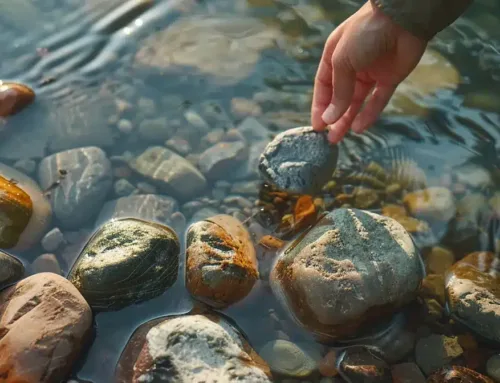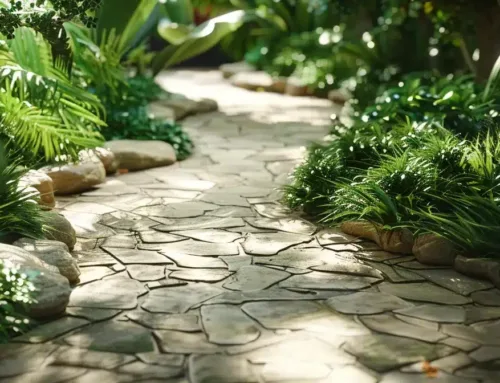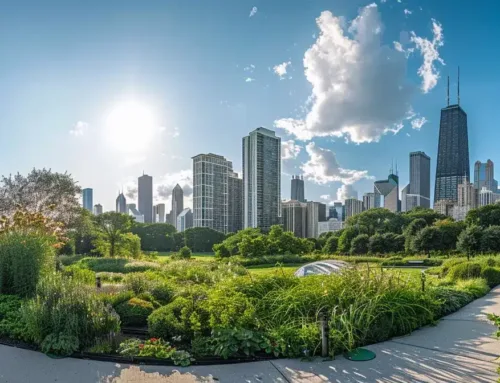Crafting the perfect backyard oasis often begins with selecting the right hardscape materials that not only complement your space but also stand the test of time. Whether you’re integrating a serene water feature beside a cozy fireplace or shaping a tranquil pond encircled by lush plantings, the durability and aesthetics of your chosen materials—from natural stones to artisanal tiles—are paramount. As a connoisseur of landscape services, I understand how the quality and harmony of these elements can elevate any water feature from a simple addition to a stunning focal point. In this article, I’ll guide you through the process of choosing materials that fuse both beauty and practicality for your outdoor water features.
Understanding Hardscape Materials for Water Features

Choosing the right hardscape materials for your water feature, whether it’s nestled in a quaint courtyard or adorning a robust stone wall, is akin to selecting the perfect piece of jewelry to complement an outfit. It’s not just about aesthetics, though; factors like durability and maintenance play a large role as well. As we venture deeper into the nitty-gritty of stone, concrete, and glass options, I’ll share with you the ins and outs of both natural and manufactured materials. From the rustic charm of rock formations to the sleek modernity of steel accents, each choice carries its own set of benefits and considerations. So, let’s roll up our sleeves and ensure your water feature is not only a dazzling focal point but also a lasting addition to your hardscape.
Evaluating Stone, Concrete, and Glass Options
When I sift through options for enhancing garden design with water features, I often find myself drawn to the timeless allure of concrete. Its malleability before setting allows it to take on almost any shape, crafting anything from elegant, cascading waterfalls to serene pond surrounds. But it’s the aging process, where concrete develops a unique patina, that truly captivates me, proving that beauty in a garden can mature just like the finest culinary masterpiece from a well-loved kitchen. Importantly, while concrete is robust, I always remind my clients to consider sealants to prevent corrosion, ensuring longevity in their picturesque aquatic havens.
Pros and Cons of Natural vs. Artificial Materials
Deciding between natural stone and artificial materials such as precast concrete can significantly influence the ambiance of your outdoor spaces. While natural stone harmoniously merges with the landscape, becoming a focal point that ages gracefully alongside your flourishing gardens, it often carries a considerable weight which can impact installation logistics. On the flip side, artificial options like precast concrete offer a consistent look and easier handling, plus they’re less likely to strain your pump with debris, but they might lack the unique character that natural stone provides.
Importance of Durability and Maintenance
In the domain of landscape construction, the resilience of a water garden’s foundation cannot be overstated. Opting for a high-quality concrete slab as a base can prevent premature cracking and shifting, which helps preserve the serene atmosphere. Compare it to a driveway—it needs to endure constant wear while still retaining its curb appeal.
Best Stones for Your Water Feature Design
Stepping stones in design can be as impactful as those across a gently babbling brook, and picking the right stone for your water feature is just that – a critical step on the path to creating a captivating garden escape. In this section, we’ll meander through the characteristics of granite, slate, and sandstone, all robust contenders that bring their unique textures and hues into play. Matching these stones with the appropriate water flow types can be akin to a delicate dance, where harmony between force and form is key. We’ll delve into how the sturdiness of granite, the layered charm of slate, and the warm tones of sandstone can amplify the aesthetic appeal of your water element. And let’s not forget the elements that bind the scene together – cast stone edging, the prospect of cement foundations for stability, accents in glimmering copper, and even the right type and size of gravel can elevate the entire design, blending durability and beauty in a symphony of hardscape perfection.
Characteristics of Granite, Slate, and Sandstone
When we talk about the intrinsic value of stones like granite, slate, and sandstone for water features, it goes beyond just their striking good looks. Granite stands out with its hardiness, practically immune to scratches and able to shrug off weather woes, which can be as unexpected as a bird’s swoop down to the water’s edge. Slate’s fine layers, a testament to its masonry heritage, brings an elegant stratified look that can harmonize with both modern and rustic beds, while sandstone radiates warmth with its varied earthen tones, complementing greenery and blooms alike. Yet, these stones lack the pliability of plastic or stainless steel, demanding a thoughtful approach to their incorporation into the landscape:
How to Match Stones With Water Flow Types
Integrating the right stone type with the particular water flow can vastly affect the longevity and visual impact of your water feature. For example, the intrinsic strength of granite marries well with higher-velocity flows prone to causing erosion; it resists being worn down by the constant movement. Alternatively, consider the use of concrete pavers or even timber elements, where the aesthetic of wood softens the landscape, and pavers provide structure without compromising the natural vibe.
- Granite’s robust nature is perfect for dynamic water flows, mitigating erosion concerns.
- Concrete pavers work seamlessly in structured water designs, offering durability and versatility.
- Introducing wood near calm, reflective pools adds warmth and a soothing, organic feel.
Enhancing Aesthetic Appeal With the Right Stone Choice
Now, when the gentle murmur of wind brushes through outdoor living spaces, it heightens the ambiance that’s been carefully crafted with stunning retaining walls and artful stonework. The right stone choice molds the space, infusing it with a sense of permanence and grace. In my experience, a well-selected stone can transform a simple water feature into the heart of any garden, making your outdoor retreat an extension of your personal style.
Selecting Concrete for Structural Water Features
Embracing the versatility of concrete in our hardscaping projects is like tapping into a wellspring of creativity. It’s here where the rigid structure meets the pliability of nature, allowing me to mold and craft spaces that are not only functional but teeming with design finesse. As an ally in the garden, concrete adapts effortlessly, akin to pottery waiting to be shaped by an artist’s hand. Delving into the advantages of this steadfast material, I’ll guide you through tips for personalizing those finishes in ways that celebrate the raw beauty of your outdoor space, making your water feature an enviable investment. We’ll explore how, when concrete is paired with select elements, it creates a striking visual dance that elevates the entire landscape, akin to how a well-placed piece of art transforms an entire room.
Advantages of Using Concrete in Hardscaping
In my day-to-day journey crafting landscape design marvels, I’ve come to truly appreciate concrete as the backbone for any water-centric garden showcase. This steadfast composite material is not only pivotal in forming the serene skeletons of water features but also proves indispensable for managing drainage—ensuring that the life-giving fluid flows effortlessly, gracing each garden with its tranquil presence. Embracing concrete means embracing the chance to carve out a landscape that’s as enduring as it is enchanting.
Tips for Customizing Concrete Finishes
Sculpting the perfect concrete finish to complement your garden space is both an art and a science: It’s about knowing just when to add a splash of color with mineral pigments, how to play with textures, or deciding if a smooth or a stamped finish would best suit the curves and contours of your design. Whether it’s for a stately retaining wall that embraces your favorite vegetable garden or a foundational slab that needs to be as budget-friendly as it is beautiful, the right finish can make a world of difference. Understanding the interplay between concrete and the other elements in your design, such as the appropriate type of mortar, can lead to a hardscape that’s as cohesive as it is captivating:
Combining Concrete With Other Materials for Visual Impact
Integrating concrete with natural hardscape elements is a signature move for creating breathtaking scenes around a garden pond or an inviting fire pit. Considering the porosity of materials like limestone and sandstone can lead to a playground of textures and colors that beautifully contrast the stoic nature of concrete. Curating this balance is essential, ensuring each piece compleents the others and elevates the overall visual impact of the outdoor sanctuary.
- Examine the porosity of limestone and sandstone to ensure they marry well with the moisture levels around your pond.
- Contrast the cool, sturdy presence of concrete with the warm, rustic charm of sandstone for a fire pit that becomes a central gathering spot.
- Use the durability and versatility of concrete to anchor and enhance the natural beauty of stone elements within your hardscape design.
Incorporating Glass Elements Into Water Features
Introducing glass into your oasis brings a transformative element that captivates and mesmerizes. Imagine the interplay of color as sunlight dances across glass surfaces nestled within your water garden, creating reflections that can outshine even the most dazzling jewelry – it’s a synergy of transparency and brilliance that brings your hardscape to full, vibrant life. Whether compressed into solid pieces or crafted into intricate tiles, glass harmonizes with water, metal accents, and the lush surroundings of a well-decked garden. Yet, as we delve into using glass to elevate our water features, we must not overlook practical considerations such as the sturdiness required to withstand elements and the upkeep needed to maintain this lustrous allure. Join me as we reflect on finding the perfect balance between aesthetics and practicality in the realm of glass-infused hardscaping.
Using Glass to Enhance Color and Light Reflection
Integrating glass into the water features of your outdoor spaces offers a mesmerizing play of light and color, much like the reflections on a marble floor beneath a chandelier. Strategically placed, these glass elements can amplify the natural hues of surrounding mulch and vegetation, while the glistening surface discourages unwanted algae by increasing water circulation and light penetration. Contrasted with the raw strength of iron accents, glass brings an ethereal quality to your landscape, enchanting the eye and elevating the overall sensory experience.
Choosing Between Solid Glass and Glass Tiles
Deciding whether to use solid glass or glass tiles in your yard hinges on the experience you’re crafting within your outdoor living space. Solid glass, robust and sleek, can serve as a stunning centerpiece, especially when paired with textured elements like stamped concrete or flagstone, to create that sought-after balance. Conversely, glass tiles invite a playful mosaic that interlaces with the existing hues and textures, enriching the tapestry of your personal oasis.
Maintenance and Durability of Glass in Water Environments
Choosing the right glass material is essential for ensuring both beauty and longevity in my clients’ water features. For instance, I often recommend fiberglass for those who are looking for durability coupled with a budget-friendly unit price. While traditional glass can create stunning effects, especially when paired with elements like slate in a walkway or bronze accents near a fountain, fiberglass offers incredible resilience with minimal maintenance, resisting the common rigors that outdoor environments impose.
Balancing Beauty and Functionality
As we sculpt our outdoor spaces into living works of art, it’s imperative we tread thoughtfully, choosing materials that harmonize with nature rather than disturb it. Assessing the environmental impact of the materials slated for our next pond or garden pathway isn’t just a responsible choice—it’s a creative opportunity. From the risk of rust compromising metal-integrated designs to the pH influence of certain stones on the surrounding soil, every detail matters. Prioritizing the intersection where aesthetic allure and ecological sensitivity meet, we must also consider how the materials interact with natural light. The ultimate goal is crafting a masterpiece that not only shines under the sun or beneath the moon’s glow but remains safe and enduring. In evaluating hardscape materials, we delve into their resilience against seasonal changes—how do they stand up to the freeze-thaw cycle? Attention to these details ensures our water features remain as timeless and robust as a cherished sculpture, offering tranquility season after season.
Assessing the Environmental Impact of Materials
It’s essential to consider how our choices resonate far beyond our own backyard stream or patio; the materials we pick can have a ripple effect on the wider climate. Opting for eco-friendly hardscape materials, like sustainably sourced glass or low-impact cast iron, stands as a testament to our commitment to the planet. Not only do these selections contribute to a healthier outdoor living space, but they also show a deep regard for the earth’s wellbeing.
Safety Considerations for Material Selection
In my years of experience crafting idyllic backyards, I’ve learned that safety is paramount when it comes to hardscape material selection, particularly for water features destined for your patio or garden. The price tag of materials is often a reflection of both quality and safety, which is why I encourage you to do thorough research and even consult a trusted website before making a final decision. It’s about striking the balance between the allure and the elements—ensuring the enduring beauty of your space without compromising the wellbeing of those who will enjoy it.
Longevity and Seasonal Changes Effects on Materials
When I counsel clients about their landscape dreams, longevity sits at the heart of our discussions, particularly in climates where the seasons turn as predictably as the hands of a clock. I’ve seen how materials like basalt endure through biting winters and unforgiving summers, while resin offers a more flexible yet durable alternative. And when clients express a love for timeless charm, I often suggest brick pathways or stone veneer accents which are proven to stand the test of time, thriving even as the seasons cycle from frost to bloom and back again.
Innovations in Water Feature Materials
As we dive further into our conversation about the best materials for water features, it’s crucial to shine a spotlight on the innovations shaping our industry. Porcelain and ceramic have emerged as eco-friendly frontline options, championing both sustainability and style with materials that not only replicate the opulence of natural stone but also offer the resilience we crave. Reinforced concrete, now more sophisticated than ever, provides heightened durability, challenging traditional perceptions with its newfound elegance. Exploring ideas that fuse technology with utility allows us to peer into the future, predicting trends and potential applications that promise to redefine our waterfalls and aquatic designs. Join me as we unravel the advances and innovative uses that are steering the course for water feature materials.
Exploring Eco-Friendly and Recycled Materials
In the journey of creating a captivating fountain that’s both sustainable and awe-inspiring, I’ve noticed a growing march towards the use of eco-friendly and recycled materials. The focus isn’t just on appearance; it’s about advertising a message of environmental responsibility. Utilizing recycled glass and reclaimed stone not only minimizes the consumption of raw resources like sand but also showcases innovation and care for our planet.
- Choosing recycled glass provides an eco-conscious sparkle to fountain designs.
Technological Advances Improving Durability and Aesthetics
With a keen eye on the latest advancements, I’ve witnessed the fascinating evolution of hardscape materials engineered for superior performance. Innovative composites now merge resilience with ravishing beauty, promising a new era for garden columns that can withstand harsh elements without compromising their stateliness. The joy of introducing these cutting-edge innovations into my client’s landscapes feels a bit like being at the forefront of a new wave of marketing for the industry, showcasing durability and aesthetics as twin pillars of modern hardscaping.
Future Trends in Water Feature Material Uses
Peering into the crystal ball of landscaping, I predict that water features will embrace materials that marry smart technology with sustainability. Imagine smart stones that not only enhance the ambience of a babbling brook with responsive lighting but also monitor water quality and adjust filtration systems seamlessly. It’s a future where the materials used in our serene ponds and cascading waterfalls work diligently behind the scenes to maintain the perfect balance, ensuring our backyard retreats stay as pristine as nature intended.
Conclusion
Selecting the ideal hardscape materials for your water features is crucial in achieving a harmonious blend of functionality and visual appeal in your outdoor space. The right materials, like granite or concrete, ensure durability and can withstand the elements, while maintaining the aesthetic integrity of the design. Incorporating eco-friendly and innovative materials can enhance the environment and offer low-maintenance solutions for a sustainable oasis. Ultimately, thoughtful material selection anchors the beauty and longevity of water features, enriching the overall landscape experience.




